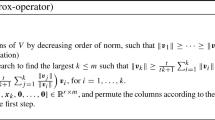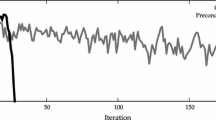Abstract
We consider the problem of experimental design for linear ill-posed inverse problems. The minimization of the objective function in the classic A-optimal design is generalized to a Bayes risk minimization with a sparsity constraint. We present efficient algorithms for applications of such designs to large-scale problems. This is done by employing Krylov subspace methods for the solution of a subproblem required to obtain the experiment weights. The performance of the designs and algorithms is illustrated with a one-dimensional magnetotelluric example and an application to two-dimensional super-resolution reconstruction with MRI data.
Similar content being viewed by others
References
Atkinson, A.C., Donev, A.N.: Optimum Experimental Designs. Oxford University Press, Oxford (1992)
Bai, Z., Fahey, M., Golub, G.: Some large-scale matrix computation problems. J. Comput. Appl. Math. 74, 71–89 (1996)
Banerjee, O., Laurent, E., d’Aspremont, A.: Model selection through sparse maximum likelihood estimation for multivariate Gaussian or binary data. J. Mach. Learn. Res. 9, 485–516 (2008)
Bardow, A.: Optimal experimental design for ill-posed problems, the meter approach. Comput. Chem. Eng. 32(1–2), 115–124 (2008)
Bauer, I., Bock, H.G., Körkel, S., Schlöder, J.P.: Numerical methods for optimum experimental design in DAE systems. J. Comput. Appl. Math. 120, 1–15 (2000)
Boyd, S., Vandenberghe, L.: Convex Optimization. Cambridge University Press, Cambridge (2004)
Chaloner, K., Verdinelli, I.: Bayesian experimental design: A review. Stat. Sci. 10, 237–304 (1995)
Chung, J., Haber, E., Nagy, J.: Numerical methods for coupled super-resolution. Inverse Probl. 22, 1261–1272 (2006)
Curtis, A.: Optimal experimental design: Cross borehole tomographic example. Geophys. J. Int. 136, 205–215 (1999)
Elad, M., Feuer, A.: Restoration of a single super-resolution image from several blurred, noisy, and undersampled measured images. IEEE Trans. Image Process. 6(12), 1646–1658 (1997)
Fedorov, V.V., Hackl, P.: Model-Oriented Design of Experiments. Lecture Notes in Statistics. Springer, Berlin (1997)
Figueiredo, M., Nowak, R., Wright, S.J.: Gradient projection for sparse reconstruction: application to compressed sensing and other inverse problems. IEEE J. Sel. Top. Signal Process., 586–597 (2007)
Friedman, J., Hastie, T., Tibshirani, R.: Sparse inverse covariance estimation with the graphical lasso. Biostatistics 9, 432–441 (2008)
Gilles, L., Vogel, C.R., Bardsley, J.M.: Computational methods for a large-scale inverse problem arising in atmospheric optics. Inverse Probl. 18, 237–252 (2002)
Golub, G., Von Matt, U.: Tikhonov regularization for large scale problems. Technical Report SCCM 4-79 (1997)
Haber, E.: Numerical Strategies for the Solution of Inverse Problems. PhD thesis, University of British Columbia (1997)
Haber, E., Ascher, U., Oldenburg, D.: On optimization techniques for solving nonlinear inverse problems. Inverse Probl. 16, 1263–1280 (2000)
Haber, E., Horesh, L., Tenorio, L.: Numerical methods for experimental design of large-scale linear ill-posed inverse problems. Inverse Probl. 24(5), 055012 (2008)
Hanke, M., Hansen, P.C.: Regularization methods for large-scale problems. Surv. Math. Ind. 3, 253–315 (1993)
Hansen, P.C.: Rank-Deficient and Discrete Ill-Posed Problems. SIAM, Philadelphia (1997)
Hansen, P.C., Nagy, J., O’Leary, D.: Deblurring Images: Matrices, Spectra, and Filtering. SIAM, Philadelphia (2006)
Hutchinson, M.F.: A stochastic estimator of the trace of the influence matrix for Laplacian smoothing splines. J. Commun. Stat. Simul. 18, 1059–1076 (1990)
Kelley, C.T.: Iterative Methods for Optimization. SIAM, Philadelphia (1999)
Lin, C.J., More, J.: Newton’s method for large bound-constrained optimization problems. SIAM J. Optim. 9, 1100–1127 (1999)
Maurer, H., Boerner, D., Curtis, A.: Design strategies for electromagnetic geophysical surveys. Inverse Probl. 16, 1097–1117 (2000)
Nagy, J., Palmer, K.: Steepest descent, CG and iterative regularization of ill-posed problems. BIT Numer. Math. 43, 1003–1017 (2003)
Oldenburg, D.W.: One-dimensional inversion of natural source magnetotelluric measurements. Geophysics 44, 1218–1244 (1979)
O‘Leary, D.P., Simmons, J.A.: A bidiagonalization-regularization procedure for large-scale regularization of ill-posed problems. SIAM J. Sci. Stat. Comput. 2, 474–489 (1981)
Orchard, J.: His Brain. Retrieved March 26, 2010, from The University of Waterloo website: http://www.cs.uwaterloo.ca/jorchard/mri/, 2005, April 27
Pukelsheim, F.: Optimal Design of Experiments. Wiley, New York (1993)
Tenorio, L., Andersson, F., de Hoop, M., Ma, P.: Data analysis tools for uncertainty quantification of inverse problems (Submitted)
van den Berg, E., Friedlander, M.P.: Probing the Pareto frontier for basis pursuit solutions. SIAM J. Sci. Comput. 31, 890–912 (2008)
Vapnik, V.: The Nature of Statistical Learning Theory. Springer, Berlin (1995)
Vogel, C.: Computational Methods for Inverse Problems. SIAM, Philadelphia (2001)
Whittall, K.P., Oldenburg, D.W.: Inversion of Magnetotelluric Data for a One Dimensional Conductivity. SEG Monograph, vol. 5 (1992)
Author information
Authors and Affiliations
Corresponding author
Rights and permissions
About this article
Cite this article
Haber, E., Magnant, Z., Lucero, C. et al. Numerical methods for A-optimal designs with a sparsity constraint for ill-posed inverse problems. Comput Optim Appl 52, 293–314 (2012). https://doi.org/10.1007/s10589-011-9404-4
Received:
Published:
Issue Date:
DOI: https://doi.org/10.1007/s10589-011-9404-4




